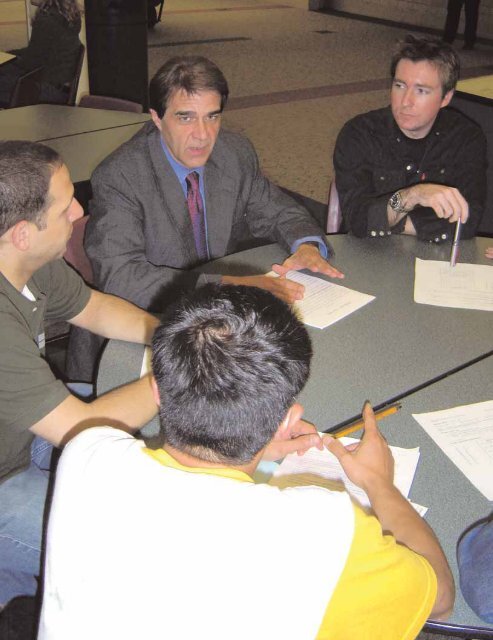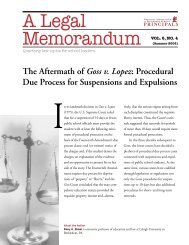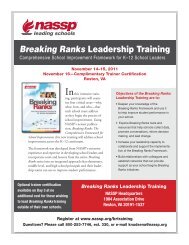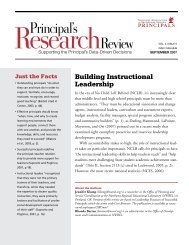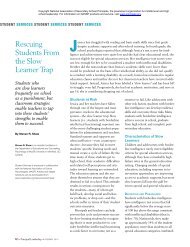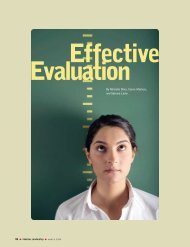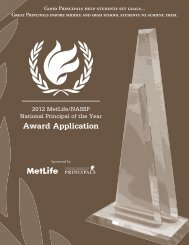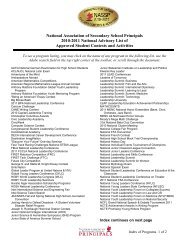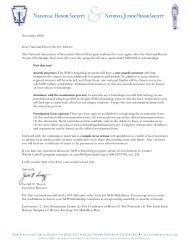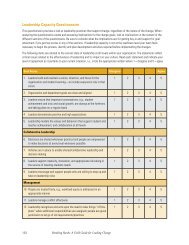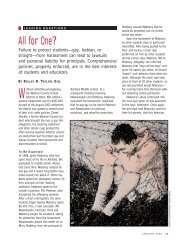Collaborative Cultures Communities of Practice
Collaborative Cultures Communities of Practice
Collaborative Cultures Communities of Practice
- No tags were found...
You also want an ePaper? Increase the reach of your titles
YUMPU automatically turns print PDFs into web optimized ePapers that Google loves.
SPECIALFEATURECollabor ative<strong>Cultures</strong>Comm unities<strong>of</strong> <strong>Practice</strong>When a school achieves a balance between individual autonomy and collaborative work, it canharness all <strong>of</strong> its intelligence, creativity, and leadership to solve problems and be successful.BY THOMAS J. SERGIOVANNIPHOTO COURTESY OF DAN GALLOWAYCompetence in a school is too <strong>of</strong>tendivided among different people. Thatteaching is regarded as an individualpractice, in strong contrast to what isfound in most other pr<strong>of</strong>essions, is aperfect example: The consequence <strong>of</strong>such division dilutes what each individualknows and ignores the collectiveintelligence that schools mightotherwise have. Without this collectiveintelligence, it is doubtful thatclosing the achievement gap and resolvingother intractable problemswill ever become more than wishfulthinking.The reason for concern is simple:It is organizational competence thatmakes schools smarter. According toWilkins (1989), “Competence in anyorganization can rarely be traced to asingle individual. Organizational competencetypically resides in the relationships,norms, memories, habits,and collective skills <strong>of</strong> a network <strong>of</strong>people” (p. 41). Simply put, organizationalcompetence is the sum <strong>of</strong>everything everybody knows and usesthat leads to increased learning. Thiscompetence is measured not only bywhat we know but also by how muchThomas J. Sergiovanni (tsergiov@trinity.edu) is the Lillian Radford Pr<strong>of</strong>essor <strong>of</strong>Education at Trinity University in San Antonio, TX. His latest book, Strengthening theHeartbeat: Leading and Learning Together, is available from Jossey-Bass.<strong>of</strong> it we know, how widely what weknow is distributed, how broad itssource is, how much <strong>of</strong> it is appliedcollectively, and how much <strong>of</strong> it isgenerated by cooperation with others.In an organizationally competentschool, everyone has a role that defineshis or her obligations and everyoneis part <strong>of</strong> a reciprocal relationshipthat spells out mutual obligations.Reciprocal role relationships enableinformal communities <strong>of</strong> practice tobubble up and institutionalized collaborativecultures to trickle down.When such informal communities <strong>of</strong>PL SEPTEMBER 2004 49
SPECIALFEATUREPHOTO COURTESY OF DAN GALLOWAYTim Foley (r.), a communication arts teacher, and Dan Galloway, principal, share their views in acurriculum meeting.practice and institutionalized collaborative cultures arejoined, schools achieve the desired balance between individualautonomy and collaborative work.Bronowski (1978) explains that, although many pr<strong>of</strong>essionshave evolved into communities where competencemultiplies because it is aggregated, other pr<strong>of</strong>essions havenot. Bronowski uses science as an example:I want to turn your attention now to the community <strong>of</strong>scientists. Because you see, what has made science successfulas a social leaven over that last three hundredyears is its change from the practice <strong>of</strong> individuals, howevergreat their ingenuity, to a communal enterprise.Leonardo da Vinci was born in 1452. He died in 1519.No scientific society existed at that time.... And one reasonwhy immensely prolific, vivid, imaginative, andinventive brains like Leonardo’s failed to make anyimpact on the body <strong>of</strong> science was that there were nocolleagues. There were colleagues in painting, and theyundoubtedly had an influence which produced moreand better paintings than we would otherwise have....Even that tremendous mind could not work in isolation.(pp. 122–123)When collaborative cultures work, each person has a rolethat defines his or her obligations and is part <strong>of</strong> a reciprocalrelationship that spells out mutual obligations. When informalcommunities <strong>of</strong> practice and institutionalized collaborativecultures are joined, we find the balance we need betweenindividual autonomy and collaborative work.<strong>Communities</strong> <strong>of</strong> <strong>Practice</strong>One school that has struck theright balance is Adlai StevensonHigh School in Lincolnshire, IL.Leaders at Stevenson realize thatauthentic student centeredness requiresthat concern for studentsand their learning be embedded ina culture that values teachers, investsin their learning, and encouragestheir pr<strong>of</strong>essionalism.Consider, for example, howStephanie Neuberger, a new teacherat Stevenson, described her interviewexperience. Neuberger’s experienceswith selection at Stevensonsuggest that the social studies divisionis both a community <strong>of</strong> practiceand a collaborative culture:“That morning, I observed in fourdifferent classrooms and began toget a better idea <strong>of</strong> what Stevenson’sculture includes. Althougheach <strong>of</strong> the teachers I observed hadvastly different styles <strong>of</strong> teaching,they all shared a few commonalities,namely, an obvious passion for their subject and a sense<strong>of</strong> truly caring about their students.”After spending the day visiting classrooms and visitingwith Eric Twadell, the social studies division director, aboutwhat she observed, Neuberger was invited back for a panelinterview. She noted that the panel put her at ease while sheanswered questions and indicated agreement at times. Thefinal step in the interview process was having Twadell observeher teaching and talk to her about what he had seen.Once Neuberger was hired, the support continued: “Afteraccepting a position at Stevenson, I began to learn moreabout Stevenson’s culture that summer. One <strong>of</strong> the subjectsI would be teaching was AP psychology, so the psychologyteam had a few meetings to discuss curriculum and methods<strong>of</strong> teaching. The unbelievable amount <strong>of</strong> support andguidance I received over the course <strong>of</strong> the school year wasforeshadowed by the events <strong>of</strong> the summer. During thesummer months and thereafter, the other AP psychologyteachers walked me through how to teach the course on aday-by-day basis.”Neuberger’s story exemplifies how important beingteacher centered is to schools that value teaching and learning.The leaders at Stevenson realize that authentic studentcenteredness requires that concern for students and theirlearning be embedded in a culture that values teachers, investsin their learning, and encourages their pr<strong>of</strong>essionalism.Neuberger concluded, “I could not possibly count all thetimes I arrived at my desk to find a lesson plan or <strong>of</strong>fers to&50 PL SEPTEMBER 2004
TEACHINGCIVICS(p. 89). By definition, leadership and norms go together. Thusthe effectiveness <strong>of</strong> leadership is measured by its effect on culturalnorms. And because leadership bubbles up from belowand trickles down from above, there is no clear-cut monopolyon norm setting. In an environment <strong>of</strong> leadership by entitlement,if you care enough about the school and its work and ifyou care enough for your colleagues, then you are obliged tobe concerned about what the existing norms are and whetherthese norms are helpful in achieving our purposes.Veteran Stevenson teacher Carol Levin sums up how collaborativecultures build the capacity <strong>of</strong> teachers and makeschools more effective places for students to learn: “On a smallscale, collaboration is what happens every day among colleaguesin department <strong>of</strong>fices as we refine our daily lessonplans. We talk as a matter <strong>of</strong> course about student comprehension,student skills, teacher effectiveness, and how to improveon them all. On a larger continuum, the collaborative cultureat Stevenson manifests itself in team meetings that actively involveevery teacher in the building. Teaching teams consistentlycome together reinforced by their common subject matterand their unflagging efforts to push both the curriculumand student success forward.“The team approach is successful because teachers feel weare given the opportunity to meet productively, not be roboticallybrought together for some forced reason. Teachers workcomfortably together because we are empowered to generategoals from within our own ranks, goals that are important toour instruction, goals that we perceive as beneficial to the teamand to our students. Because teams monitor their ownprogress, it’s very easy to keep setting goals that raise the bar.The collaborative configuration encourages both individualand collective dialogue and reflection. Teachers share best practices,successful approaches, failures (which sometimes teachmore than successes), and new ideas. We feel that our voicesare regularly solicited, considered, and valued by our colleagues.No wonder we buy into collaboration.” PLAUTHOR’S NOTEInterviews with Dan Galloway, the principal <strong>of</strong> AdlaiStevenson High School; teachers Stephanie Neubergerand Carol Levin; and John Carter, the director <strong>of</strong> themath division, were conducted in June 2003.References❏ Bronowski, J. (1978). The origins <strong>of</strong> knowledge and imagination.New Haven: Yale University Press.❏ Druskat, V. U., & Wolff, S. B. (2001). Building the emotionalintelligence <strong>of</strong> groups. Harvard Business Review, 79(3), 80–90.❏ Hargreaves, A. (1989). Contrived collegiality and the culture <strong>of</strong>teaching. Presentation at the annual meeting <strong>of</strong> the Canadian Societyfor the Study <strong>of</strong> Education, Quebec City, Canada.❏ Wilkins, A. L. (1989). Developing corporate character: How to successfullychange an organization without destroying it. San Francisco: Jossey-Bass.Advertisement52 PL SEPTEMBER 2004


